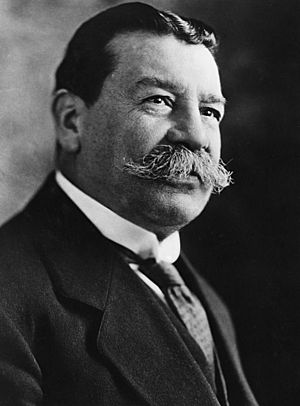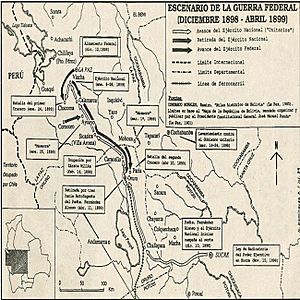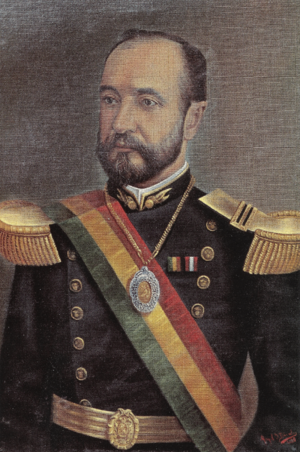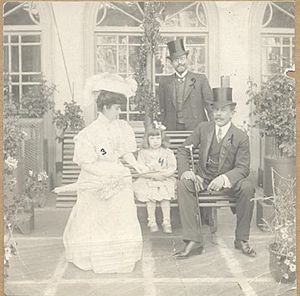Ismael Montes facts for kids
Quick facts for kids
Ismael Montes
|
|
|---|---|
 |
|
| 26th President of Bolivia | |
| In office 14 August 1913 – 15 August 1917 |
|
| Vice President | Juan Misael Saracho (1913–1915) José Carrasco Torrico |
| Preceded by | Eliodoro Villazón |
| Succeeded by | José Gutiérrez Guerra |
| In office 14 August 1904 – 12 August 1909 |
|
| Vice President | Eliodoro Villazón Valentín Abecia Ayllón |
| Preceded by | José Manuel Pando |
| Succeeded by | Eliodoro Villazón |
| President of the Central Bank of Bolivia | |
| In office 1931–1933 |
|
| Preceded by | Juan Perou Cusicanqui |
| Succeeded by | Luis Calvo |
| Minister of War and Colonization | |
| In office 16 December 1901 – 27 October 1903 |
|
| President | José Manuel Pando |
| Preceded by | José Carrasco Torrico |
| Succeeded by | Fermin Prudencio |
| Minister of War | |
| In office 27 October 1899 – 16 January 1901 |
|
| President | José Manuel Pando |
| Preceded by | Joaquín Eusebio Herrero |
| Succeeded by | José Carrasco Torrico |
| Personal details | |
| Born |
Ismael Montes Gamboa
5 October 1861 La Paz, Bolivia |
| Died | 16 October 1933 (aged 72) La Paz, Bolivia |
| Political party | Liberal |
| Spouse | Bethsabé Montes |
| Parents | Clodomiro Montes Tomasa Gamboa |
| Education | Higher University of San Andrés |
| Signature | |
| Military service | |
| Allegiance | Bolivia |
| Branch/service | Bolivian Army |
| Rank | General |
| Battles/wars | War of the Pacific
Acre War Chaco War |
Ismael Montes Gamboa (born October 5, 1861 – died October 16, 1933) was a Bolivian general and important political figure. He served as the 26th president of Bolivia two separate times. His first term was from 1904 to 1909, and his second was from 1913 to 1917. During his first time as president, a very important agreement called the Treaty of Peace and Friendship with Chile was signed.
Contents
Early Life and Military Service
Ismael Montes was born in La Paz, Bolivia, on October 5, 1861. His family was wealthy and owned a lot of land. His parents were General Clodomiro Montes and Tomasa Gamboa.
In 1878, Montes began studying law at the Universidad Mayor de San Andrés (UMSA). However, in February 1879, the Chilean army took over the Bolivian town of Antofagasta. This event started the War of the Pacific. Montes decided to stop his studies and join the army as a private soldier.
In 1880, Montes's army group fought in the Battle of Alto de la Alianza. This was a major battle between Bolivia and Chile. Montes was badly wounded but survived. He was then captured by the Chilean army and remained a prisoner until the war ended.
When he returned to Bolivia, Montes was promoted to captain because of his bravery. After the war ended in 1880, he worked as an instructor in the Bolivian army. However, in 1884, Montes left the army to finish his law studies. He earned his law degree on June 12, 1886.
Political Career
In 1890, when he was 29 years old, Montes was elected as a Deputy. This meant he represented his region in the government. He belonged to the Liberal Party (Bolivia). His ideas were quite different from the traditional conservative views of the time. Montes also became the head of Civil Law at the UMSA law school.
As a Deputy, Montes was known for being very polite and a good speaker. He worked closely with Atanasio de Urioste Velasco, another strong liberal leader. They remained good friends and allies throughout their lives.
The Bolivian Civil War (1898-1899)
Why the War Started
For many years, there was a debate about which city should be the official capital of Bolivia. Until the 1880s, the government's main office was wherever the president lived. Sucre was officially the capital, but by the 1880s, presidents often stayed in Sucre, making it the de facto (unofficial) capital.
In October 1898, some government leaders from Sucre wanted to make Sucre the permanent capital. This was called the "Radicatory Law." Leaders from La Paz suggested moving the Congress to Cochabamba, a neutral city, but this idea was rejected. The Liberal Party seemed to agree with making Sucre the capital at first. They did this on purpose, knowing that if the law passed, they could convince the people of La Paz to protest.
On November 6, there was a big riot in La Paz. People demanded that their city become the capital and that the country adopt a "federal" system, where different regions have more power. On November 14, a Federal Committee was formed, led by Colonel José Manuel Pando. Three days later, the "Radicatory Law" was approved, making Sucre the official capital.
In response, on December 12, the people of La Paz formed a Federal Board of Liberals. Colonel Pando's liberals also teamed up with Pablo Zárate Willka, a powerful leader of the indigenous people in the Altiplano region.
War Begins
After these events, the leaders from La Paz left the Congress. The people of La Paz welcomed them with big celebrations. The main goal of the federalists was to remove President Severo Fernández from power. In Sucre, people supported the government.
President Fernández marched towards La Paz with his army. He learned that the rebels had many weapons, so he asked for more volunteers in Sucre. During their march, the government forces took supplies from the local indigenous villages.
The government's first group of soldiers met Pando's forces in Cosmini. They were forced to hide in a church in Ayo Ayo and were attacked on January 24, 1899. In other cities like Potosí, people refused to help the government. In Santa Cruz and Tarija, people stayed neutral. However, in many indigenous communities, people supported the Liberals.
The most important battle of the civil war was the Battle of Segundo Crucero on April 10, 1899. President Fernández and Pando's armies met there. After four hours, Pando's troops won. The defeated government forces went to Oruro, and soon after, President Fernández went into exile. Throughout this war, Montes was a loyal supporter of the Liberal cause and fought under Pando's command.
After the Civil War
Montes attended an important meeting in Oruro to discuss Bolivia's future. When Pando was elected President, Montes became the Minister of War for Bolivia and was promoted to colonel. As minister, Montes worked to improve the army. He made it more disciplined and gave it modern equipment. Montes also led a military group to fight against Brazilian adventurers in the north of the country during the Acre War (1900-1903). After this war, he focused completely on politics, hoping to become president after José Manuel Pando.
In 1904, his party chose him as their candidate for president in the general elections. He won the election, defeating his opponent, Lucio Pérez Velasco.
President of Bolivia
First Term (1904-1909)
On October 20, 1904, a very important agreement was signed: the Treaty of Peace and Friendship with Chile. This treaty officially ended the state of war between the two countries, which had been ongoing since the War of the Pacific. In this treaty, Montes recognized that Bolivia would give up its coast, which Chile had taken.
Many historians believe that Chile pressured Bolivia to sign this treaty. The Liberal governments of Pando and Montes thought it was time to move on. They believed that the development of railways and free trade, which were part of the treaty, were worth giving up the coast.
Montes also signed a trade agreement with Peru in 1905. As a strong liberal, Montes introduced new laws. He made civil marriage legal, allowed freedom of worship (people could practice any religion), and ended the special legal power of the church. These changes caused problems between the Holy See (the Pope and the Catholic Church) and the Bolivian government. He also modernized the Bolivian Army by bringing French military experts to train the soldiers.
In the 1908 elections, Montes's government supported Fernando Eloy Guachalla for president. Guachalla won, but he became ill and died before he could become president.
Because Guachalla died before taking office, the Liberal Party in Congress, influenced by Montes, decided that the Vice President, Eufronio Viscarra, could not take over. This allowed Montes to stay in office for an extra year. In the 1909 elections, another Liberal candidate, Eliodoro Villazón Montaño, won the presidency.
Second Term (1913-1917)
In 1913, Montes returned to Bolivia from Europe to run for president again. He won the elections easily and became president for the second time. One of his most important actions was creating the Central Bank of Bolivia. This bank was very important for managing the country's economy.
During his second term, some members of the Liberal Party started to disagree with him. Many of them left to join the new Republican Party, which former president Pando had started in 1914. As his term ended, Montes supported José Gutiérrez Guerra to be the next president. Gutiérrez won, which meant the Liberal Party stayed in power.
After his presidency, Montes became Bolivia's ambassador to France. In 1920, while he was in Paris, the Liberal Party was removed from power in Bolivia by the Republicans. This meant Montes had to stay in France in exile until 1928. In 1928, he returned to Bolivia to lead the Liberal Party again.
He also served as President of the Central Bank of Bolivia from 1931 to 1933.
The Chaco War and Final Years
Ismael Montes had a long and impressive military career. He fought in the War of the Pacific in 1879, the Civil War of 1898-1899, and the Acre War of 1900-1903. These experiences gave him great military knowledge and respect across the country. Because of this, during the Chaco War (1932-1935), President Daniel Salamanca asked Montes to be a military advisor to the Bolivian army in the Chaco region.
Montes did not live to see the end of the Chaco War. While still working as a military advisor, he died suddenly on October 16, 1933, in La Paz, due to his old age.
Images for kids
See also
 In Spanish: Ismael Montes para niños
In Spanish: Ismael Montes para niños





